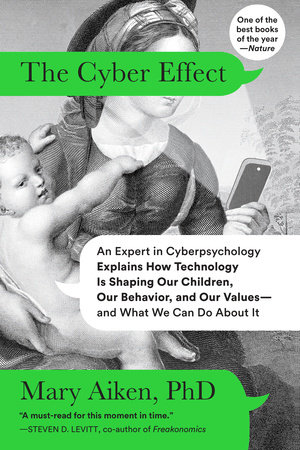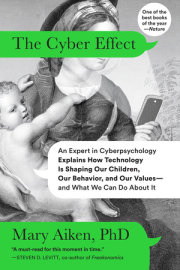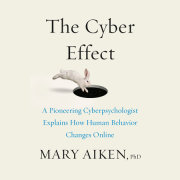Chapter 1
The Normalization of a Fetish
Human behavior has always been affected and shaped by technology, but there has been no greater influence, as far as I can see, than the advent of the Internet. You don’t have to be an expert in the subject of online behavior to have observed that something about cyberspace provokes people to be more adventurous.
The illusion is that the cyber environment is safer than real life—and connecting with other people online somehow carries fewer risks than face-to-face contact. But our instincts were trained and honed for the real world, and in the absence of real-world cues and other subtle pieces of information—facial expressions, body language, physical spaces—we aren’t able to make fully informed decisions. And because we aren’t face-to-face when we are communicating and interacting with others online, we can be anonymous or, more important, we feel we are. As discussed in the prologue to this book, we can feel freed up and emboldened online. People can lose their inhibitions and in a way “act drunk” because, for some, being in the cyber environment can impair judgment and increase impulsivity, somewhat similar to the way alcohol can. Disinhibition is facilitated by the environmental conditions of cyberspace—by the perceived lack of authority, the anonymity, as well as the sense of distance or physical remove.
You see this in the changing courtship rituals of self-curated selfies and sexts, and in flirtatious exchanges on social-networking sites. Online, we feel more comfortable being bold and explicit. An individual may demonstrate common sense, rationality, and restraint in real life and check these qualities at the door when entering cyberspace. Why?
In cyberpsychology, the explanation for this emboldened behavior is known as the online disinhibition effect, first introduced by John Suler and now highly cited and accepted by academics in the field. Another powerful factor comes into play, which I have studied and written about, online escalation. It is a construct or concept that I use to describe how problem behaviors become bigger—or amplified—online, as many of us have already witnessed in everything from supernegative exchanges via flaming emails, aggressive texts, and offensive posts to comment threads that are meant to provoke.
It isn’t that technology is bad for us—or inherently negative. Problems occur when we are ignorant of its impact. Most people don’t understand the effect that the environment of cyberspace can have on them. They think it’s the same as anywhere else. Individuals who behave impulsively, or struggle with a tendency to act rashly, may be especially vulnerable. But due to the effect of online escalation, anyone can move more quickly into new behavior and new norms.
Later on, in a chapter about cyber romance, I will discuss the new ways people meet, make friends, form communities, and find meaningful personal connections online. In this chapter, though, I’ll be exploring the impact of technology on a smaller slice of the population, specifically individuals with a fetish or paraphilia—what is considered atypical sexual behavior. Why bother looking so closely at one specific population online? By studying the extreme effects of technology on fringe or unusual behavior, we begin to see more clearly the implications of the cyber environment for all of us. As a forensic cyberpsychologist, I’ve seen this demonstrated time and again: Whenever technology comes in contact with an underlying predisposition, or tendency for a certain behavior, it can result in behavioral amplification or escalation.
I would argue that tendencies and vulnerabilities that cause the most distress in real life may become even more of a battle online. That goes for any behavior.
If these tendencies aren’t destructive or risky, the impact can be fairly benign. If someone just loves to visit online forums for gardeners, there isn’t much that’s self-destructive about that. But there are many incidences of risky behavior becoming much riskier online, especially pathological and criminal behavior. Here’s an example of what I mean: A stalker in the real world typically focuses on one victim at any given time, but a cyberstalker can stalk multiple victims simultaneously because technology makes that possible. Cyberstalking is considered an evolution of a real-world criminal behavior. Cyberspace is a breeding ground for mutations. Real-world behavior migrates there and escalates or accelerates. This can sometimes have serious implications in the real world.
A Case of Cranking
Jordan Haskins had grand dreams of making a difference in sparsely populated Saginaw County, Michigan, his hometown. The pale, clean-cut twenty-three-year-old man described himself as “pro-life, pro-family, pro-freedom, and pro-faith.” In the summer of 2014, while still a student at Maranatha Baptist University, he announced he was running for political office, hoping to serve as a state representative to Michigan’s 95th District. He posed for his campaign website photograph with the best smile he could muster, his image superimposed on a background of a billowing American flag, a sepia-toned Declaration of Independence, and artwork that appeared to be the three crosses of Calvary, synonymous with crucifixion, in dark outline.
The Republican candidate said his love of history, philosophy, religion, and politics had led him to run for office—and give back to society. He’d realized that his gift was for government.
“I’ve found my niche,” he said, “my passion.”
He had other passions, as it turns out. Before his campaign was fully under way, he found himself needing to explain his criminal record. He had been charged and pleaded guilty to four violations of trespassing on private and public property and unlawful use of government vehicles during a period of ten months in 2010 and 2011.
When interrogated by police at the time of his arrest, Haskins admitted that he had twice broken into a government yard where a mosquito-control pickup truck and sheriff’s cruiser were parked in order to pull the spark-plug wires loose on the vehicles, sit in the front seat of the cars, and masturbate while listening to the engines sparking.
This behavior is called “cranking,” he explained to police. He was sentenced to one year and eight months in prison in 2011. Parole was lifted just eleven days prior to the election. “I was in a messed-up state of mind mentally and emotionally when I did what I did,” the candidate told the local media when asked in 2014 about his felony convictions. “That’s the only way I can even explain it.”
Cranking? What on earth possessed him to jump the fence into the police department parking lot, break into a car, and the rest . . .
“It was just the fun and the risk and the thrill,” Haskins said.
And how had he discovered this bizarre fetishistic behavior?
“I read about it online.”
Anatomy of a Fetish
At the back of New Age shops and hippie stores, next to the incense and patchouli oil, you’ll find shelves of little carvings for sale. Inspired by the practices of Native American animism and West African religious cults, these small charms in the shape of animals are believed to be imbued with supernatural powers, carrying energy, communications from the spirit world—or simply good luck. Each of these objects is called a “fetish.”
The use of the word fetish for an object that causes sexual arousal is attributed to French psychologist Alfred Binet, who is best known for devising the earliest intelligence tests. In common usage, a fetish describes a strong compulsion or desire for a particular condition or activity. A woman might say, lightheartedly, “I have a shoe fetish,” meaning to suggest that she spends a disproportionate amount of her income on footwear. A man might say that stiletto heels excite him. In fact, feet and objects associated with feet are the most common fetishes. In psychology, fetishistic disorder is a mental health condition centering on the use of inanimate objects as a source of sexual satisfaction.
What causes one to develop a fetish in the first place? Sigmund Freud argued in his famous 1927 essay on fetishism that sexual fetishes were the result of arrested psychosexual development. Freud wrote: “When now I announce that the fetish is a substitute for the penis, I shall certainly create disappointment; so I hasten to add that it is not a substitute for any chance penis, but for a particular and quite special penis that had been extremely important in early childhood but had later been lost. . . .”
Interestingly, Freud believed that the predominance of foot and shoe fetishes could be explained by a child’s early memories of being on the floor and peering up a woman’s skirt.
Freud’s views and theories have many critics. Numerous contemporary psychologists are skeptical of his therapeutic approach, psychoanalysis, and have distanced themselves from it. I happen to value the work of Freud because it often helps to illuminate complex behavioral issues, and these days psychoanalytic theory has also advanced well beyond Freud’s ideas. More contemporary psychoanalytic approaches have different explanations for fetishes, and describe how they can become a way for individuals to maintain a cohesive sense of self. But in general, other schools within psychology now hold sway, from Jean Piaget’s theory of cognitive development to Erik Erikson’s theory of psychosocial development. Currently there’s enormous interest in biopsychology, and how the brain and neurotransmitters influence our behavior.
I suspect if he were alive today, Freud would be keenly interested in the impact of technology on humankind. Since he argued that sexual impulses were at the root of most behavior, I’m sure he would identify sexual impulses as a contributor to some cyberbehavior.
Is sex behind all obscure behavior? Even Freud himself supposedly once said, “Sometimes a cigar is just a cigar.”
Childhood experiences, though, do seem to explain some fetishes. As psychologist Robert Crooks and sex therapist Karla Baur write in their academic textbook, Our Sexuality, a boy may associate arousal with objects that belong to an emotionally significant person. The process of this association is sometimes referred to as symbolic transformation, when the object of the fetish becomes imaginatively endowed with the power or essence of its owner. In contemporary psychoanalysis the fetish is a self object, or an object that represents a significant other—usually a parent.
Some experts argue that fetishistic behavior has similarities with obsessive-compulsive disorder. And like OCD, once ingrained, a fetish is an urge that is difficult to deny—a behavior that is very hard to resist. The conditioning process is commonly thought by modern psychologists to reinforce the fetish. Like Russian physiologist Ivan Pavlov’s famous dogs that salivated whenever they saw Pavlov’s lab assistant, because they anticipated being fed, there is an anticipation of a reward when seeing the fetish object or thinking about the fetish behavior. In Haskins’s cranking case, he had prior arrests as a juvenile for breaking into cars and joyriding, and perhaps these were thrilling adventures that he continually wanted to relive. Each time he broke into a car, his behavior was rewarded—reinforcing and strengthening the fetish. The more he took risks to do a little cranking, the more ingrained the behavior became. This is how conditioning works.
The growing number of websites catering to sexual fetishes involving cars (including pedalsupreme.com, which offers “pedal pumping, engine cranking, leg and foot videos and pictures”) is a sign that this is an escalating trend. There is also a YouTube channel, pumpthatpedaldotcom, which offers a new installment every week. According to sexologist Dr. Susan Block, one possible psychological explanation for this behavior is that the “ ‘vroom’ of the engine reminds them of their own libidos being revved up.”
A fetish can be created in a lab. In one classical conditioning experiment a group of male subjects in a laboratory were repeatedly shown erotic slides of nude women. Occasionally, an image of women’s boots would appear in the slideshow. Soon the men had a sexual response to the photograph of boots alone, and over time they responded to images of other types of women’s shoes. If a photograph of a pair of women’s boots could be used so easily to condition desire, imagine how the Internet with its infinite supply of images could inspire, instill, and sustain a fetish.
That brings us back to Jordan Haskins, who lost the election for the 95th District after he’d become a viral story—and the subject of unkind scrutiny and fascination. “You may not respect my policies, you may not respect my ideas, but you at least have to respect me as a person,” Haskins said. But I don’t think too many people did.
Politicians + Paraphilia
Unusual sexual behaviors were once labeled “deviant” or “perverted,” even in clinical references. More recently, a less charged, less judgmental umbrella term, paraphilia, was adopted to describe a range of atypical behaviors that include fetishes. Paraphilia means “beyond usual or typical love.” This alludes to the fact that these behaviors are not commonly associated with a traditional romantic relationship. Given the apparent rise in the number of websites catering to paraphilia, atypical sexual behavior may be becoming more common.
You don’t have to look too far for examples in public life of individuals who, like Jordan Haskins, had everything to lose—and lost it—when unusual or bizarre sexual behavior was exposed. I’m thinking of U.S. congressman Anthony Weiner and the explicit photographs of himself that he sent to unsuspecting women he’d met online. I’m thinking of U.S. senator David Vitter and his urge to be diapered, which required the services of prostitutes. And I’m thinking of New York governor Eliot Spitzer, who insisted on keeping on his calf-length black socks when he had sex with a call girl. Remarkably enough, the marriages of these politicians survived after their unusual sexual habits came to light. The actor David Carradine, who was found dead and hanging inside a hotel room closet, wasn’t so fortunate. According to an ex-wife, he was into an extremely dangerous autoerotic asphyxiation paraphilia called hypoxyphilia, consisting of practices that restrict the flow of oxygen to the brain for sexual arousal.
The Diagnostic and Statistical Manual of Mental Disorders, Fifth Edition, or DSM-5, the most recent version of the standard classification of mental disorders used by mental health professionals worldwide, breaks down paraphilia into eight main types of disorders: exhibitionistic disorder, fetishistic disorder, frotteuristic disorder, pedophilic disorder, sexual masochism disorder, sexual sadism disorder, transvestic disorder, and voyeuristic disorder. The behavior being described in most of these terms is probably not too difficult to figure out, since the clinical words have entered common speech, with the exception of frotteurism, a disorder in which a person derives sexual pleasure or gratification by rubbing himself, or his genitalia, against another person—usually in a crowd (a good reason to avoid overly crowded subway cars at rush hour).
Copyright © 2016 by Mary Aiken. All rights reserved. No part of this excerpt may be reproduced or reprinted without permission in writing from the publisher.








